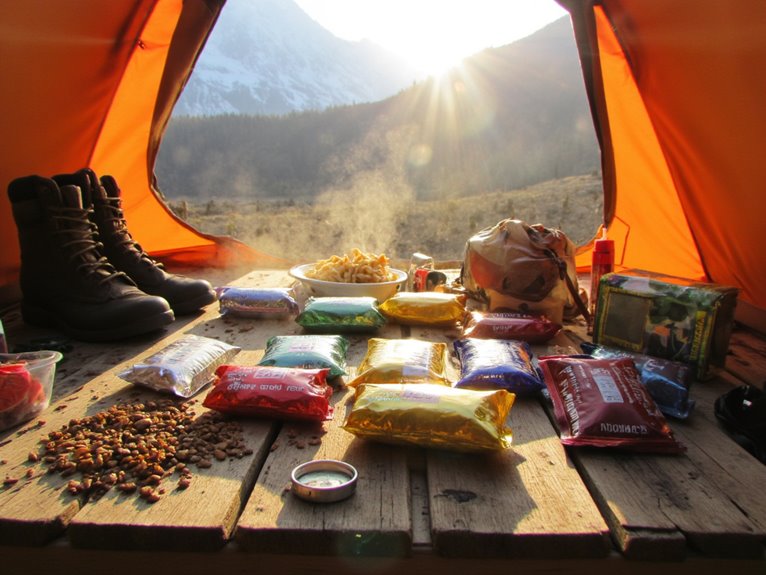Are Camping Tarps Worth It?
Camping tarps are a vital piece of gear for outdoor enthusiasts, providing reliable protection from the elements and enhancing overall camping comfort and safety. A well-designed tarp can withstand harsh weather conditions, keeping users dry and comfortable. It's essential to think about factors such as weight, bulk, rain and wind protection, sun shade, and UV protection when selecting a tarp. Additionally, moisture management, setup and takedown ease, and alternative shelter options should not be overlooked. By understanding these key factors, campers can make informed decisions and enrich their outdoor experiences – and there's more to discover in the world of camping tarps.
We are supported by our audience. When you purchase through links on our site, we may earn an affiliate commission, at no extra cost for you. Learn more. Last update on 15th January 2026 / Images from Amazon Product Advertising API.
Weight and Bulk Considerations
Every ounce counts when backpacking, and camping tarps are no exception, with even a few extra pounds or bulkier designs potentially making a significant difference in overall comfort and mobility.
When selecting a camping tarp, it's essential to weigh the importance of the weight and bulk of the design.
Ultralight backpackers, in particular, should prioritize tarps that weigh under 1 pound, with compact packing sizes that won't occupy valuable space in their packs.
Look for tarps made from lightweight, yet durable materials, such as silnylon or Dyneema.
Additionally, examine tarps with removable or adjustable components to further minimize weight and bulk.
Rain and Wind Protection
One of the most critical functions of a camping tarp is to provide reliable protection from rain and wind, making it essential to choose a design that can effectively shield you from the elements.
A well-designed tarp should be able to withstand harsh weather conditions, keeping you dry and comfortable.
Look for tarps with a waterproof and breathable material, such as silnylon or polyester, and a durable stitching that can resist strong winds.
The tarp's shape and angle of pitch also play a vital role in deflecting rain and wind.
A tarp with a steep angle of pitch will allow rain to run off quickly, while a more horizontal pitch may allow snow to accumulate.
Sun Shade and UV Protection
While a camping tarp's primary function is to provide shelter from rain and wind, it's just as essential to think about its ability to provide sun shade and UV protection, especially during warmer months or in regions with intense sunlight.
A tarp's sun shade capabilities can make a significant difference in keeping your campsite cool and comfortable.
Look for tarps with a UPF (Ultraviolet Protection Factor) rating, which indicates the fabric's ability to block UV rays.
A higher UPF rating means better protection for your skin and gear.
Additionally, consider tarps with a silver or aluminum coating, which can reflect sunlight and heat, further reducing the risk of heat exhaustion and UV damage.
Ground Cloth and Moisture
Moisture management is a critical aspect of camping tarp selection, as a tarp's ability to regulate ground moisture can substantially impact the comfort and safety of your campsite.
A tarp that effectively manages moisture can prevent water from seeping into your tent and reduce the risk of mold and mildew growth.
Look for tarps with a waterproof and breathable design, such as those made from silicone-coated nylon or polyester fabrics.
A ground cloth, which is a waterproof layer placed under your tent, can also help to manage moisture.
When choosing a ground cloth, consider the terrain and weather conditions you'll be camping in, and select a material that can withstand the elements.
Setup and Takedown Hassles
When selecting a camping tarp, consider the setup and takedown process, as a tarp that is difficult to assemble or disassemble can quickly become a frustrating addition to your camping gear.
A tarp that requires excessive poles, stakes, or complicated attachments can be a hassle to set up, especially in windy or rainy conditions.
Look for tarps with simple, color-coded attachments and intuitive design.
Additionally, consider the tarp's weight, size, and storage requirements to facilitate it can be easily transported and stowed away.
A well-designed tarp should be easy to set up and take down, allowing you to focus on enjoying your camping trip rather than struggling with your gear.
Alternative Shelter Options
Consider alternative shelter options, such as canopies or gazebos, which can provide similar protection from the elements as a tarp, but offer more structural integrity and versatility.
These alternatives can provide a more robust and stable shelter, ideal for camping trips or outdoor events. Canopies and gazebos often come with walls, floors, and even windows, providing better protection from wind, rain, and sun exposure.
Additionally, they can be easily set up and taken down, making them a convenient option. Moreover, many modern canopies and gazebos are designed to be portable and lightweight, making them easy to transport.
If you're looking for a more substantial shelter option, consider exploring these alternatives to traditional camping tarps.


